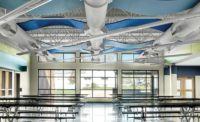Controlling Sound Reflection in Multi-purpose Spaces
No place for reflection



Reverberation Time (Rt60) is the time it takes for the sound to fall 60 dB after the source has been turned off.







The clock’s winding down. The game is tied. The bleachers are packed to the rafters. Coaches are shouting plays. Cheerleaders are chanting encouragement. The pep band and the fans are producing a deafening sound.
Now, fill that same gymnasium with a different kind of crowd. On the court is a stage set for graduation. Parents, students, and faculty are beaming. But as the first words come out of the speaker’s mouth, the reaction is, “Huh? I can’t understand her.”
Two special events. Two different experiences. So how can a school make the gymnasium work for different events? Appropriate acoustical treatment is an excellent place to start. Plain, simple, easy, but often overlooked. Most K-12 schools are already on a tight budget, so the school gymnasium must serve multiple functions. Fortunately, a wide spectrum of new technologies and advanced acoustical products can help schools and other multi-purpose facilities achieve opposing acoustical goals.
Sound Reflection Takes Center Stage
When considering a space, sound reflection should be examined first. Sound reflection takes place when a sound wave strikes a structural surface such as a ceiling, floor, wall or any other object with a large enough surface area, then returns or “reflects” back to the source of the sound. This creates an echo. If the echo returns back quickly enough, it may seem to be part of the original sound, forming a reverberation instead of an echo.1
Reverberation is the continuation of sound once it is produced. As sound reflects off of surfaces (i.e., bouncing around a room), it lessens or loses intensity. Too much reverberation makes it difficult to understand what’s being said.
Reverberation Time
Reverberation time (RT) is the measurement of how long it takes for sound to decay. It plays a key role in determining what acoustic treatments are needed. The desired reverberation time depends on the room’s purpose. Published literature places the optimum range for good speech intelligibility in a classroom, lecture hall or small theatre at 0.6 to 2.0 seconds. The optimum range for a “live” space such as an auditorium, symphonic or concert hall is from 1.4 to 2.6 seconds.2
For large, open rooms like gymnasiums, sound reflection off the high ceiling, hardwood floor and solid walls is ideal for a sporting event. Basketball and volleyball games create high reverberation. To keep sound at a reasonable level to create a fun team environment, sound reflection will only need to be a 2.0 to 3.0 second reverberation time.
When adding an acoustical product to a multi-purpose room such as a gymnasium, the “sweet spot” is a reverberation time (RT) of 2.0 to 3.0 seconds.3
Low reverberation is desired when the gymnasium is used for speaking events. Increasing the volume on an amplified sound system will not fix the situation. It merely increases the volume of the sound at the listener’s ear, rendering the speaker unintelligible. If the room is too reverberant, the loudspeaker system will increase the amount of acoustical energy in the space and make the decay louder rather than reduce the decay time. The sound system must work with the room’s acoustic design. Once the room is right acoustically, then the sound system can be adjusted properly.
Diagnosing Sound Problems
“The challenge is to find a happy medium—a moderate amount of reverberation that works in the space for both types of events,” says Chuck Walthall, Walthall & Associates Inc., Consultants in Acoustics, AV & Digital Technologies.
Typically, most K-12 schools are on limited budgets and often, acoustical treatment is value engineered out of the original design. In theory, it seems reasonable. In reality, a gymnasium without some form of acoustical treatment functions poorly. Most gymnasiums and other multi-purpose rooms are giant boxes—four walls, floor and ceiling. Sound reverberates off hard surfaces. Without materials to absorb and buffer sounds, words become unintelligible—whether from a sound system or from the person next to you.
Fortunately, an acoustical consultant or a representative from an acoustics company can access the room’s needs and offer affordable solutions. Many noise problems are easily solved. However, different types of sound reduction require different tactics.
To get started, an acoustical professional will need to know the following:
- Cubic volume of space: width, length and ceiling height determine a room’s cubic volume.
- Construction material of reflective surfaces: ceiling, walls, flooring, windows, even furnishings reflect sound. Specific materials such as concrete block, drywall, wood flooring, and metal decking have acoustical values that can be calculated into an overall recommendation for the space.
- People/Occupancy: since the human body is absorptive, people do absorb sound and thus, occupancy load does affect a room’s acoustics.
- Activities, or how the room is used: classroom, lecture hall, band or music room, gymnasium, cafeteria, office space, church, theatre—all have different sound control requirements.
- Current problems: humming of HVAC or office equipment, noise from the corridor or adjoining rooms, noise from outside the building, excessive reverberation, unintelligible PA system, etc.
- Sound solution goals: this aligns with how the room will be used. A gymnasium must reduce crowd noise so that players, referees and coaches can communicate safely while ensuring that the PA system is intelligible. A band director must be able to hear individual instruments playing. A church or large room must ensure the audience can hear clearly. Classrooms and office space must maintain a quiet environment for learning and working.
Another Concern—the Potential for Hearing Damage
A school gymnasium can be an acoustic nightmare since it attracts so much noise. Room size, reflective surfaces, people and activities contribute to high decibel levels, creating a perfect storm for hearing damage.
When dealing with a gymnasium’s acoustics, the school district must consider whether someone can be injured in such a highly reverberating space. The noise level in a crowded gym can exceed 100dB (decibels). Coaches may have a hard time talking to players. Players may miss cues shouted across the court. Add in the noise of the crowd and high-pitched whistles over a two-hour game, exposure to this level of reverberation will impact hearing.
The chart adjacent shows that dB levels in gymnasiums often exceed standard acceptable levels.
Controlling Sound Reflections
Acoustic treatments for a gymnasium are often eliminated from the construction budget, as schools are generally on a very tight budget. Once a gymnasium is put to use, the lack of proper acoustical treatment becomes obvious. Luckily, it is an easy and affordable fix. Most retrofit acoustic solutions will include products that absorb sound. The challenge is how to reduce sound reverberation, and that means adding absorptive material to lower reverb time and prevent reflections from bouncing off the ceiling, hard flooring and walls.
“We are shooting for a target of something like 2.0 - 3.0 seconds of decay. Not dead, but not overly loud. It has enough control to meet the happy medium to support both sporting events and spoken word events,” according to Walthall.
To properly fit a gymnasium for sound control, an acoustical professional will determine if any treatments already exist and measure the levels of reverberation for performance. Once these levels of reverberation are known, the acoustical professional can determine how much additional absorption is needed to reduce the levels to meet the end goal, which is speech intelligibility.
The Right Products for Gymnasium Ceilings
The ceiling is a great place to start when retrofitting acoustical treatments. There are a variety of products to absorb sound. These products hang from existing ceiling grid systems or from roof decks and bar joists in open ceiling areas. They are constructed in a variety of materials and can be covered with fabric, printed images, words, or custom-shaped. For gymnasiums, an acoustical professional will make recommendations from an assortment of suspended application products that are applied directly to the ceiling. Banners are the best choices for gyms, because they are extremely durable, can be installed to the ceiling deck and can handle a wayward basketball or volleyball.
- Accent Baffles control sound by isolating noise and absorbing sound in an open ceiling.
- Baffles can define open spaces and add depth to ceilings while isolating noise and absorbing sound. Baffles are available with fabric, white texture, PVC or nylon finishes.
- Banners are the most economical sound-absorbing ceiling product.
Baffles help to reduce the overall reverb time (RT) of the room while suspended from the ceiling, out of the way. Banners are hung horizontally along the ceiling and absorb sound, offering the same advantages as acoustical wall panels.
Acoustical Treatments for Walls
There are many options for acoustical wall treatments. Acoustic sound absorbing panels can be creatively made with options for color, material, shapes and printed images. Many schools use their acoustic panels to showcase team logos, colors or other branded identities. All wall products should be installed above the door frames.
- Acousti-Panels reduce noise reverberation and are the most economical sound-absorbing wall panel products. These can be created with printed images for unlimited design potential.
- Custom Shaped Acousti-Panels offer sound absorption in endless design possibilities with custom cutting, shaping and finishing for individual panels or full wall applications.
The best acoustical treatment should always include a variety of products working together to address problems. For large open spaces, a minimum of 30 to 40 percent of the ceiling and walls should be covered.4 Baffles reduce overall reverberation time. Banners and Acousti-Wall Panels provide sound-absorbing capabilities. With the selection of products available in today’s acoustics market, no two projects are ever the same. W&C
Sources:
Reference.com, “What is the Reflection of Sound?” https://www.reference.com/science/reflection-sound-1670d3cdd1d9726b
HGC Engineering’s Ear to the Ground blog, “The Acoustical Challenges of Gyms with Auditorium and Classroom Uses.” https://acoustical-consultants.com/built-environment/acoustical-challenges-of-mixed-use-school-gym-auditoriums-classrooms/
Golterman, Herb. (2018, March). How a Smart Acoustics Plan Can Save an Open, Interior Space. Walls & Ceilings magazine, https://www.wconline.com/articles/91434-how-a-smart-acoustics-plan-can-save-an-open-interior-space
Soundproofing America Inc., “Soundproofing A Gymnasium.” https://www.soundproofingamerica.com/gym-soundproofing/
While not really “silent,” the new gymnasium and other workout areas at the brand-new rec center in Fairview Heights, IL had the reverberation time reduced thanks to the creative use of acoustical treatments.
G&S Acoustics manufactured and supplied a variety of acoustical treatments throughout the new facility. One of the best examples of product use is the two-level gymnasium that is surrounded by an upper level running track. The ceiling for the entire area utilizes White Ceiling Banners and the walls of the upper level track are treated with Black Resolute Sound-Absorbing Wall Panels. This allows both spaces to be enjoyed simultaneously without exceeding recommended reverberation times.
Looking for a reprint of this article?
From high-res PDFs to custom plaques, order your copy today!
















